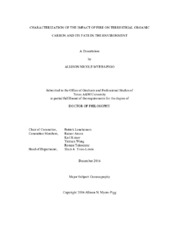| dc.description.abstract | Pyrogenic carbon (PyC) is a heterogeneous continuum of compounds resulting from incomplete combustion of organic matter. The understanding of PyC in the environment has mainly focused on high-temperature combustion by-products. However, the portion of this continuum produced at low temperatures, mainly during wildfire and prescribed burning events, is particularly labile and water-soluble. Therefore, low-temperature PyC is imperative to study during dynamic transport across environmental interfaces. This dissertation presents new characterization of low-temperature PyC at the interfaces of terrestrial, aquatic and atmospheric environments. I use biomarkers of biomass combustion, plant materials, and inorganic tracers to elucidate sources, composition, and degradation of PyC during transport within and between environmental reservoirs.
In large Arctic rivers, low-temperature PyC biomarkers are present in detectable concentrations during all flow regimes. PyC export occurs predominately in the dissolved phase and is an intrinsic component of the DOC pool mobilized by hydrologic events. Around half of the low-temperature PyC exported may be remineralized during transit time from fire source to river mouth, implying a labile source of PyC to these watersheds. Phase partitioning of low-temperature PyC suggests that it sorbs to particles at levels orders of magnitude higher than what equilibrium theory would predict. The higher than expected association of these soluble components with particles may help explain the recorded presence of these biomarkers in sedimentary deposits, which have helped track historical wildfire signatures in watersheds. However, as partitioning coefficients of low-temperature PyC biomarkers are lower than those reported for high temperature PyC biomarkers, there is a higher potential for exchange with the aqueous phase and thus accessibility to microbial degradation during transport to the coastal ocean, especially during the spring freshet.
In the atmosphere, low-temperature PyC biomarkers may be more labile than previously considered, with potential abiotic degradation (such as hydroxyl radical reactions) occurring on time scales relevant to atmospheric transport (days). As this could affect the composition of PyC biomarkers at depositional sites, the assumption that they are conservative in the atmosphere must be questioned.
This dissertation quantifies PyC dynamics to help solidify flux and pool estimates and missing parameters in model assessments of carbon cycling. | en |


